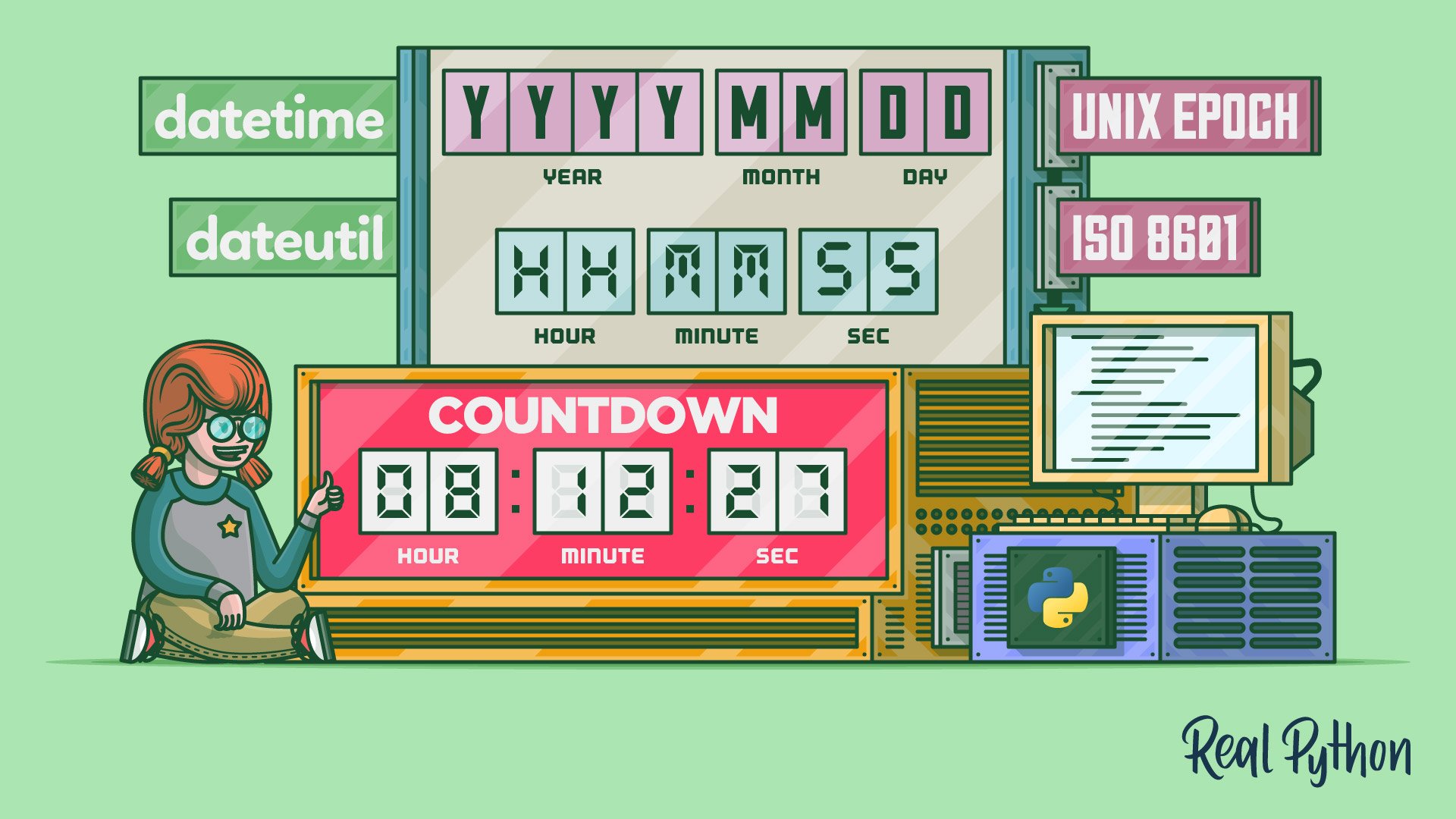
Finishing Your PyCon Countdown
Finishing Your PyCon Countdown 관련
You now have enough tools in your belt to finish your PyCon 2021 countdown clock and provide a nice interface to use as well. In this section, you’ll use relativedelta to calculate the time remaining until PyCon, develop a function to print the time remaining in a nice format, and show the date of PyCon to the user.
Using relativedelta in Your PyCon Countdown
First, replace the plain subtraction operator with relativedelta. With the subtraction operator, your timedelta object couldn’t count intervals of time larger than a day. However, relativedelta allows you to show the years, months, and days remaining:
1# pyconcd.py
2
3from dateutil import parser, tz
4from dateutil.relativedelta import relativedelta
5from datetime import datetime
6
7PYCON_DATE = parser.parse("May 12, 2021 8:00 AM")
8PYCON_DATE = PYCON_DATE.replace(tzinfo=tz.gettz("America/New_York"))
9now = datetime.now(tz=tz.tzlocal())
10
11countdown = relativedelta(PYCON_DATE, now)
12print(f"Countdown to PyCon US 2021: {countdown}")
The only change that you made in this code was to replace line 11 with countdown = relativedelta(PYCON_DATE, now). The output from this script should tell you that PyCon US 2021 will happen in about one year and one month, depending on when you run the script.
However, that output isn’t very pretty since it looks like the signature of relativedelta(). You can build up some prettier output by replacing line 11 in the previous code with the code below:
11def time_amount(time_unit: str, countdown: relativedelta) -> str:
12 t = getattr(countdown, time_unit)
13 return f"{t} {time_unit}" if t != 0 else ""
14
15countdown = relativedelta(PYCON_DATE, now)
16time_units = ["years", "months", "days", "hours", "minutes", "seconds"]
17output = (t for tu in time_units if (t := time_amount(tu, countdown)))
18print("Countdown to PyCon US 2021:", ", ".join(output))
This code requires Python 3.8 because it uses the new walrus operator. You can make this script work on older versions of Python by using a traditional for loop in place of line 17.
In this code, you define time_amount(), which takes two arguments, the unit of time and the relativedelta instance from which the time units should be retrieved. If the amount of time is not equal to zero, then time_amount() returns a string with the amount of time and the time unit. Otherwise, it returns an empty string.
You use time_amount() in the comprehension on line 17. That line creates a generator storing the non-empty strings returned from time_amount(). It uses the walrus operator to assign the return value of time_amount() to t and includes t only if it is True.
Finally, line 18 prints the final output using .join() on the generator. Next, you’ll take a look at including the PyCon date in the output from your script.
Showing the PyCon Date in Your PyCon Countdown
Earlier, you learned about creating datetime instances using .strptime(). This method uses a special mini-language within Python to specify how the date string is formatted.
Python datetime has an additional method called .strftime() that allows you to format a datetime instance to a string. In a sense, it’s the reverse operation of parsing using .strptime(). You can differentiate between the two methods by remembering that the p in .strptime() stands for parse, and the f in .strftime() stands for format.
In your PyCon countdown, you can use .strftime() to print output to let the user know the date on which PyCon US will start. Remember, you can find the formatting codes that you want to use on strftime.org. Now add this code on line 18 of your PyCon countdown script:
18pycon_date_str = PYCON_DATE.strftime("%A, %B %d, %Y at %H:%M %p %Z")
19print(f"PyCon US 2021 will start on:", pycon_date_str)
20print("Countdown to PyCon US 2021:", ", ".join(output))
In this code, line 18 uses .strftime() to create a string representing the starting date of PyCon US 2021. The output includes the weekday, month, day, year, hour, minute, AM or PM, and time zone:
Text
`Wednesday, May 12, 2021 at 08:00 AM EDT
On **line 19**, you print this string for the user to see with some explanatory text. The last line prints the amount of time remaining until the PyCon start date. Next, you’ll finish your script to make it easier for other people to reuse.
### Finalizing Your PyCon Countdown
The final step that you’ll want take is to follow Python [best practices](https://realpython.com/tutorials/best-practices/) and put the code that produces output into a [`main()`](https://realpython.com/python-main-function/) function. You can check out the full, final code after applying all these changes:
```py
1# pyconcd.py
2
3from dateutil import parser, tz
4from dateutil.relativedelta import relativedelta
5from datetime import datetime
6
7PYCON_DATE = parser.parse("May 12, 2021 8:00 AM")
8PYCON_DATE = PYCON_DATE.replace(tzinfo=tz.gettz("America/New_York"))
9
10def time_amount(time_unit: str, countdown: relativedelta) -> str:
11 t = getattr(countdown, time_unit)
12 return f"{t} {time_unit}" if t != 0 else ""
13
14def main():
15 now = datetime.now(tz=tz.tzlocal())
16 countdown = relativedelta(PYCON_DATE, now)
17 time_units = ["years", "months", "days", "hours", "minutes", "seconds"]
18 output = (t for tu in time_units if (t := time_amount(tu, countdown)))
19 pycon_date_str = PYCON_DATE.strftime("%A, %B %d, %Y at %H:%M %p %Z")
20 print(f"PyCon US 2021 will start on:", pycon_date_str)
21 print("Countdown to PyCon US 2021:", ", ".join(output))
22
23if __name__ == "__main__":
24 main()
In this code, you move print() and the code used for the generator into main(). On line 23, you use the guard clause to make sure that main() only runs when this file is executed as a script. This allows other people to import your code and reuse PYCON_DATE, for instance, if they’d like.
Now you can modify this script as much as you want. One neat thing to do might be to allow the user to change the time zone associated with now by passing a command-line argument. You could also change the PYCON_DATE to something closer to home, say PyCon Africa or EuroPython.
To get even more excited about PyCon, check out Real Python at PyCon US 2019 and How to Get the Most Out of PyCon!